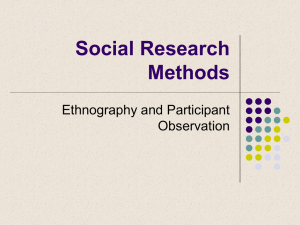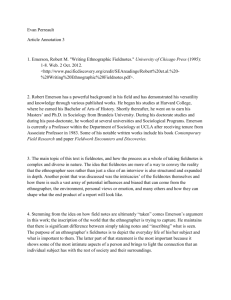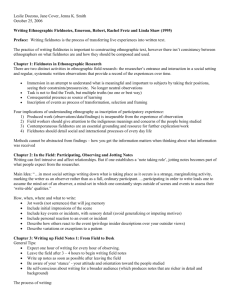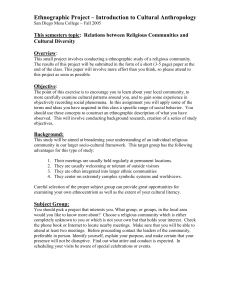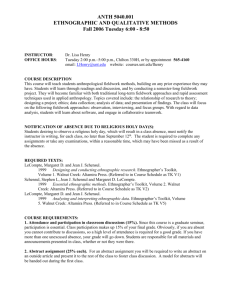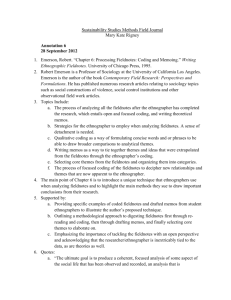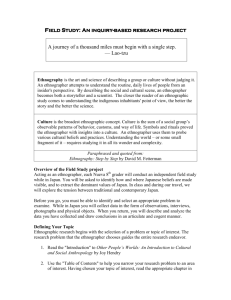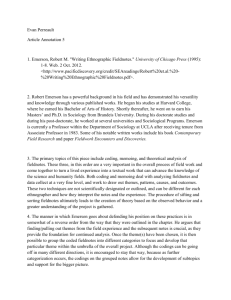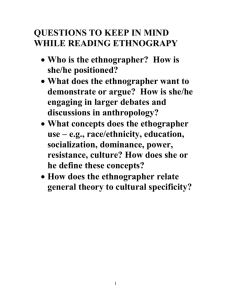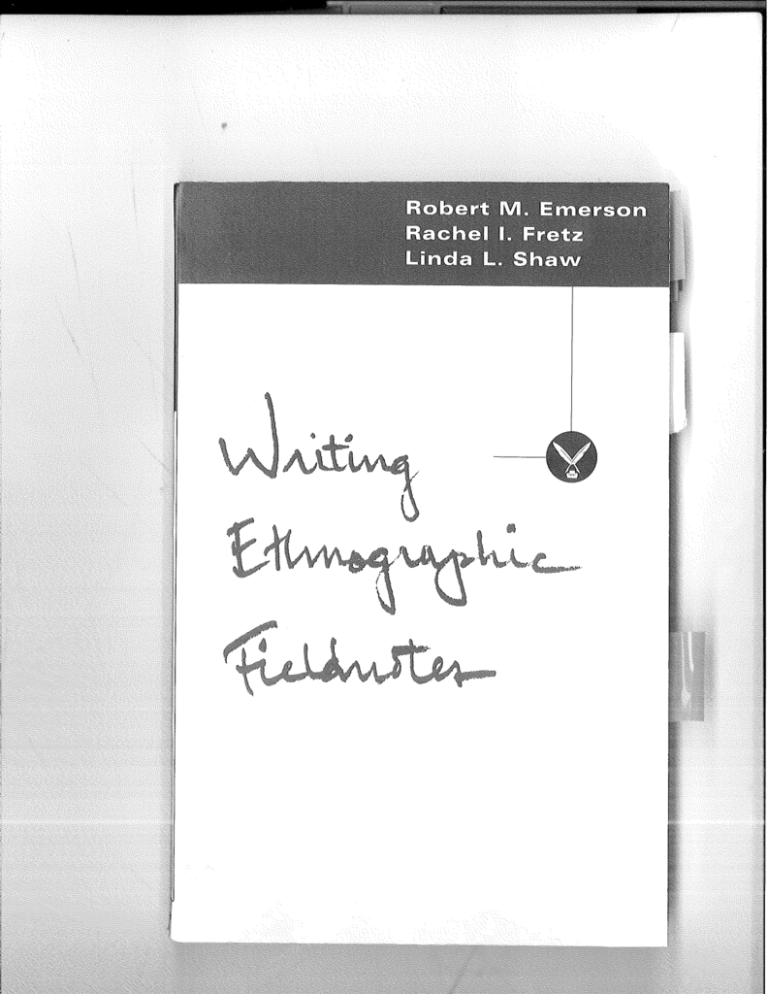
Contents
P,.Oi3rRr M. EMERSON is professor of sociology at University of California, Los
AngeJes. RÿCHEL L FmÿTZ is a folklorist who teaches ethnographic field re-
search in the Writing Program at the University of California, Los
Preface
vii
Angeles. LnVDA L. SHAW is assistant professor of sociology at Syracuse University.
one
FIELDNOTES IN ETHNOGRAPHIC RESEARCH
1
The University of Chicago Press, Chicago 60637
Ethnographic Participation
The University of Chicago Press, Ltd., London
Inscribing Experienced/Observed Realities
Implications for Writing Fiddnotes 11
© 1995 by The University of Chicago
All rights reserved. Published 1995
4
Reflections: Writing Fieldnotes and Ethnographic
Printed in the United States of America
04 03 02 01 00 99 98 97 96 95
1
Practice
15
54321
IN THE FIELD: PARTICIPATING, OBSERVING, AND JOTTING
ISBN (cloth): 0-226-20680-7
NOTES
ISBN (paper): 0-226-20681-5
17
Making Jottings: How, Where, and When
Participating in Order to Write
Library of Congress Cataloging-in-Publication Data
Two Illustrations of Jottings
Emerson, Robert M.
19
26
30
Jomngs as Mnemonic Devices: What Words and
Writing ethnographic fieldnotes / Robert M. Emerson, Rachel
Phrases?
I. Fretz, Linda L. Shaw.
p.
cm. -- (Chicago guides to writing, editing, and
publishing)
Includes bibliographical references (p.
three
) and index.
WRITING UP FIELDNOTES I: FROM FIELD TO DESK
At the Desk
ISBN 0-226-20680-7 (cloth). -- ISBN 0-226-20681-5 (pbk.)
The Process of Writing Up
3. Ethnology--Research. I. Fretz, Rachel 1. 1I. Shaw, Linda L.
Ili. Tide. IV. Series.
four
94-47093
CIP
@ The paper used in this publication meets the minimum requirements of
the American National Standard for Information Sciences--Permanence of
Paper for Printed Library Materials, ANSI Z39.48-1984.
39
42
46
Reflections: "Writing" and "Reading" Modes
GN307.7.E44 1995
35
39
Stance and Audience in Writing Fieldnotes
1. Ethnology--Authorship. 2. Ethnology--Field work.
305.8'00723--dc20
31
Reflections: Writing and Ethnographic Marginality
63
WRITING UP FIELDNOTES II: CREATING SCENES ON THE
PAGE
66
Writing Detailed Notes: Depiction of Scenes
Writing Extended Entries: Organization
68
84
In-Process Analytic Writing: Asides, Commentaries,
and Memos
100
Reflections: Fieldnotes as Products of Writing
Choices
105
xviii
PPÿEFACE
chapter one
Francisco "Chuck" Martinez, Martha Moyes, Deanna Nitta, Phil Okamoto, Blair PaleS Kristin Rains, Lisa P,.avitch, Joanna Saporito, Kristin
D. Schaefer, Joe Scheuermann, Cliff Spangler, Lakshmi Srinivas, Martha
Stokes, Kathryn L. Tatar, Laura Miles Vahle, Linda Van Leuven, Karina
Fieldnotes in Ethnographic
Research
Waiters, David Whelan, Nicholas H. Wolfinger, and Terri Young. We
especially thank Lisa Holmes and Martha Millison, not only for allowing
us to use excerpts from their fieldnotes, but also for providing a "student
response" after reading an earlier draft of the manuscript.
Ethnographic field research involves the study of groups and people as
they go about their everyday lives. Carrying out such research involves
two distinct activities. First, the ethnographer enters into a social setting
and gets to know the people involved in it; usually, the setting is not
previously known in an intimate way. The ethnographer participates in
the daily routines of this setting, develops ongoing relations with the
people in it, and observes all the while what is going on. Indeed, the term
"participant-observation" is often used to characterize this basic research
approach. But, second, the ethnographer writes down in regular, system-i,
anc ways what she observes and learns while participating in the daily .....
rounds of life of others. Thus the researcher creates an accumulating
written record of these observations and experiences. These two inter-
connected activities comprise the core of ethnographic research: Firsthand participation in some initially unfamiliar social world and the production of written accounts of that world by drawing upon such participation. In the following sections we examine in detail each of these activines and then trace out their implications for writing fieldnotes.
ETHNOGRAPHIC PARTICIPATION
Ethnographers are committed to going out and getting close to the activities and everyday experiences of other people. "Getting close" minimaUy
requires physical and social proximity to the daily rounds of people's lives
2
FIELDNOTES IN ETHNOGRAPHIC RESEARCH
ETHNOGRAPHIC PARTICIPATION
and activities; the field researcher must be able to take up positions in the ]
and understanding into these groups and their activities. Or villag-
midst of the key sites and scenes of other's lives in order to observe and
an ethnographer a role, such as sister or mother in an
understand them. But getting close has another, far more significant com-
which obligates her to participate and resocialize herself
ponent: The ethnographer seeks a deeper immersion in others' worlds in
expectations (Fretz n.d.).
order to grasp what they experience as meaningful and important. With
immersion, the field researcher sees from the inside how people lead their
about others through active participation in their lives and
the fieldworker cannot and should not attempt to be a fly on the
lives, how they carry out their daily rounds of activities, what they find
No field researcher can be a completely neutral, detached observer,
meaningful, and how they do so. In this way immersion gives the fieldworker access to the fluidity of others' lives and enhances his sensitivity
to interaction and process.
independent of the observed phenomena (Pollner and Emer1988). Rather, as the ethnographer engages in the lives and concerns
those studied, his perspective "is intertwined with the phenomenon
Furthermore, immersion enables the fieldworker to directly and forcibly experience for herself both the ordinary routines and conditions under which people conduct their lives, and the constraints and pressures to
!Which does not have objective characteristics independent of the observ}erspective and methods" (Mishler 1979:10). The ethnographer can,not take in everything; rather, he will, in conjunction with those in the
which such living is subject. Goffman (1989:125) in particular insists that
field research involves "subjecting yourself, your own body and your own
personality, and your own social situation, to the set of contingencies that
play upon a set of individuals, so that you can physically and ecologically
penetrate their circle of response to their social situation, or their work
situation, or their ethnic situation." Immersion in ethnographic research,
then, involves both being with other people to see how they respond to
events as they happen and experiencing for oneself these events and the
circumstances that give rise to them.
develop certain perspectives by engaging in some activities and
relationships rather than others. Moreover, it will often be the case that
relationships with those under study follow political fault lines in the
setting, exposing the ethnographer selectively to varying priorities and
points of view. As a result, the task of the ethnographer is not to determine "the truth" but to reveal the multiple truths apparent in others'
lives.3
Furthermore, the ethnographer's presence in a setting inevitably has
implications and consequences for what is taking place, since the field-
Clearly, ethnographic immersion precludes conducting field research
as a detached, passive observer; the field researcher can only get close to
the lives of those studied by actively participating in their day-to-day
affairs. Such participation, moreover, inevitably entails some degree of
resocialization. Sharing everyday life with a group of people, the field researcher comes "to enter into the matrix of meanings of the researched,
to participate in their system of organized activities, and to feel subject to
their code of moral regxllation" (Wax 1980:272-73). In participating as
fully and humanly as possible in another way of life, the ethnographer
worker must necessarily interact with and hence have some impact on
those studied.4 "Consequential presence" often linked to reactive effects
(that is, the effects of the ethnographer's participation on how members
may talk and behave), should not be seen as "contaminating" what is
observed and learned. Rather, these effects are the very source of that
learning and observation (Clarke 1975:99). Relationships between the
field researcher and people in the setting do not so much disrupt or alter
ongoing patterns of social interaction as reveal the terms and bases on
which people form social ties in the first place. For example, in a xÿAlage
learns what is required to become a member of that world, to experience
events and meanings in ways that approximate members' experiences2 In-
based on kinship ties, people may adopt a fieldworker into a family and
assign her a kinship term which then designates her rights and responsi-
deed, some ethnographers seek to do field research by doing and becoming-to the extent possible--whatever it is they are interested in learning
about. Ethnographers, for example, have become skilled at work activities
they are seeking to understand (Diamond 1993; Lynch 1985) or in good
faith havej oined churches or religious groups (Jules-Rosette 1975: Rochford 1985) on the grounds that by becoming members they gain fuller
bilities toward others. Rather than detracting from what the fieldworker
can learn, first-hand relations with those studied may provide clues to
understanding the more subtle, implicit underlying assumptions that are
often not readily accessible through observation or interview methods
alone,s Consequently, rather than viewing reactivity as a defect to be
carefully controlled or elminated in entirety, the ethnographer needs to
FIELDNOTES IN ETHNOGRAPHIC RESEARCH
become sensitive to and perceptive of how she is seen and treated by
others.
INSCRIBING EXPERIENCED/OBSERVED REALITIES
5
made while participating in an intense and involved manner.
descriptive accounts of experiences and observations is not as
To appreciate the unavoidable consequences of one's own presence
and transparent a process as it might initially appear. For
strips any special merit from the highly detached, "unobtrusive," and mar-
description is not merely a matter of accurately capturing as
ginal observer roles that have long held sway as the implicit ideal in field
¢ as possible observed reality, of"putting into words" overheard talk
research. Many contemporary ethnographers advocate highly participa-
activities. To view the writing of descriptions simply as a
tory roles (Adler, Adler, and Rochford 1986) in which the researcher
producing texts that correspond accurately to what has been ob-
actually performs the activities that are central to the lives of those studied.
to assume that there is but one "best" description of any particu-
In this view, assuming real responsibility for actually carrying out core
in fact, there is no one "natural" or "correct" way to write
functions and tasks, as in service learning internships, provides special op-
what one observes. Rather, because descripfons involve issues of
portunities to get close to, participate in, and experience life in previously
perception and interpretation, different descriptions of "the same" situa-
unknown settings. The intern with real work responsibilities or the re-
tions and events are possible.
searcher participating in ÿllage life actively engage in local activities and
Consider, for example, the following descriptions of moving through
are socialized to and acquire empathy for local ways of acting and feeling.
express checkout lines in three different Los Angeles supermarkets, writ-
Finally, close, continuing participation in the lives of others encourages
ten by three student researchers. These descriptions share a number of
appreciation of social life as constituted by ongoing, fluid processes.
common features: all describe events from the point of view of shoppers/
Through participation, the field researcher sees first-hand and up close
observers moving through express checkout lines; all provide physical de-
how people grapple with uncertainty and confusion, how meanings
scriptions of the other major players in the lines--the checker, other
emerge through talk and collective action, how understandings and inter-
shoppers--and of at least some of the items they are purchasing; and all
pretations change over time. In all these ways, the fieldworker's closeness
attend closely to some minute details of behavior in express lines. Yet
to others' daily lives and activities heightens sensitivivi to social life as
each of these fieldnote accounts takes a different tack in describing a
process.
supermarket express line. Each selects and emphasizes certain features and
actions, ignoring and marginalizing others. Furthermore, these descriptions are written from different points of view, and they shape and present
INSCRIBING EXPERIENCED/OBSERVED tÿ.EALITIES
what happened on the express lines in different ways--in part because
the researchers observe different people and occasions, but also in part
Even vcith intensive resocialization, the ethnographer never becomes a
because they make different writing choices:
member in the same sense that those "naturally" in the setting are members.6 The fieldworker plans on leaving the setting after a relatively brief
Mayfair Market Express Line
stay, and his experience of local life is colored by this transience. As a
There were four people in line with their purchases separated by an approx.
result "the participation that the fieldworker gives is neither as committed
18" rectangular black rubber bar. I put my frozen bags down on the "lazy susan
nor as constrained as the native's" 0Karp and Kendall 1982:257). Further-
linoleum conveyor belt" and I reached on top of the cash register to retrieve one
of the black bars to separate my items. The cashier was in her mid thirties, ap-
more, the fieldworker orients to many local events not as "real life" but
prox., about 5'2" dark skinned woman with curly dark brown hair. I couldn't
as objects of possible research interest, as events that he may choose to
hear what she was saying, but recognized some accent to her speech. She was in
write down and preserve in fieldnotes. In these ways, research and writing
a white blouse, short sleeved, with a maroon shoulder to mid thigh apron. She
commitments qualify ethnographic immersion, making the field re-
had a loose maroon bow tie, not like a man's bow tie, more hangie and fluffy.
searcher at least something of an outsider and, at an extreme, a cultural
alien.7
Her name tag on her left chest side had red writing that said "Candy" on it.
[Describes the first two men at the front of the line.] The woman behind him
was dark skinned with straight dark brown hair cut in a page boy. She was wearing
Fieldnotes are accounts describing experiences and observations the re-
a teal blue v-neck knit sweater with black leggings. In her section was juice, a
FIELDNOTES IN ETHNOGRAPHIC RESEARCH
can of pineapple juice, and a six-pack of V-8 tomato juice. The guy in front of ÿ:
to do this small favor. She was a pretty blonde woman, and was buying a
me had a pink polo shirt on and tan shorts. He was about 6'2", slender, tan with :ÿ
of champagne (maybe also for Easter brunch?). She was wearing what
blond short hair with a gold 18 gauge hoop in his left ear (I thought he was gay).
like an Easter dress--it was cotton, and pretty and flowery. She looked
In his triangle of space he had packaged carrots, a gallon of whole milk, and a
package ofporkchops.
Maybe about my age. She was quite tall for a woman, maybe 5'10"
Candy spent very little time with each person, she gave all a hello, and then
of me didn't take long at all. I've learned quite well how
told them the amount, money was offered, and change was handed back onto a
queues and not be too impatient. Boland, the checker, saw me, and
"Hi! How's it going?" or something like that ....
shelf that was in front of the customer whose turn it was. Before Candy had given
the dark-haired woman her change back, I noticed that the man in the pink shirt
had moved into her spatial "customer" territory, probably within a foot of her,
describes moving through the line as she experienced the
and in the position that the others had taken when it was their turn, in front of
!process on a moment by moment basis, framing her accounts of others'
the "check writing" shelf.. (I thought it was interesting that the people seemed
more concerned about the proper separation of their food from one another's
than they did about body location.) . . .
As [ walk up to the shelf(where it all seems to happen), I say "Hi" and Candy
says "Hi" back as she scans my groceries with the price scanner....
as she received, understood, and reacted to them. This style of
the reader unique access to the observer's thoughts and
emotions; for example, while space is an issue, it is framed in terms not
of distance but of its implications for self and feelings (e.g., avoiding "a
across the items that weren't mine").
This observer describes the line spatially in terms of individual people
In the next excerpt, the writer shifts his focus from self to others:
(particularly physical appearance and apparel) and their groceries as laid
out before being rung up ("in his triangle of space he had... "). Indeed,
Boy's Market Express Line
this account notes as an aside the contrast between the care taken to sepa-
•,. I picked a long line. Even though the store was quiet, the express line was
rate grocery items and the seeming disregard of physical space that occurs
long. A lot of people had made small purchases today. I was behind a man with
at the "check writing shelf" as one shopper is about to move on and the
next-in-line to move in.
Ralph's Express Line. Easter Morning
just a loaf of bread. There was a cart to the side of him, just sitting there, and I
thought someone abandoned it (it had a few items in it). A minute later a man
came up and "claimed" it by taking hold of it. He didn't really try to assert that
he was back in line--apparently he'd stepped away to get something he'd forgot-
ten--but he wasn't getting behind me either. I felt the need to ask him if he
I headed east to the checkout stands with my romaine lettuce, to garnish the
was on line, so I wouldn't cut him off. He said yes, and I tried to move
rice salad I was bringing to brunch, and my bottle of Gewurtztraminer, my new
behind him--we were sort of side by side--and he said, "That's okay. I know
favorite wine, which I had to chill in the next half hour. As I approached the
stands, I realized that the 10-items-or-less-cash-only line would be my best
choice. I noticed that Boland was behind the counter at the register--he's always
very friendly to me--"Hey, how you doing?"
I got behind the woman who was already there. She had left one of the rubber
where you are."
An old woman was behind me now. She had her groceries in one of those
carts that old people tend to use to wheel their groceries home. She was thumbing
through the National Enquirer, and was clutching a coupon in her hand. She
scanned a few pages of the paper, and then put it back in the rack. I looked ahead
separator bars behind the things she was going to buy, one of the few personal
at the person whose groceries were being checked out--she was staring at the
friendly moves one can make in this highly routinized queue. I appreciated this,
price for each item as it came up on the register.
and would have thanked her (by smiling, probably), but she was already looking
At this point the guy who I'd spoken to earlier, the guy who was right in front
ahead, I suppose in anticipation of checking out. I put my wine and lettuce down.
of me, showed a look of surprise and moved past me, over to an abandoned cart
There was already someone behind me. I wanted to show them the courtesy of
at the end of the aisle. He was looking at what was in it, picking up the few items
putting down a rubber separator bar for them too. I waited until the food in front
with interest, and then put them back. I thought he'd seen something else he
of mine was moved up enough for me to take the bar, which was at the front of
wanted or had forgotten. He came back over to his cart, but then a supermarket
the place where the bars are (is there a word for that? bar bin?), so that I wouldn't
have to make a large, expansive move across the items that weren't mine, drawing
attention to myself.. I waited, and then, finally, the bar was in sight. I took it, and
then put it behind my items, looking at the woman behind me and smiling at her
as I did so. She looked pleased, and a bit surprised, and I was glad to have been
employee walked by, and he called out to the man, walking over to the cart and
pointing at it, "Do you get many items like this left behind?" The employee
hesitated, not seeming to understand the question, and said no. The guy on line
said, "See what's here? This is formula [cans of baby formula]. That's poor people's
food. And see this [a copper pot scrubber]? They use that to smoke crack/' The
FIELDNOTES IN ETHNOGRAPHIC RESEARCH
employee looked surprised. The guy says, "I was just wondering. That's very
indicative of this area." The employee: "I live here and I didn't know that" The
guy: "Didn't you watch Channel 28 last night?" Employee: "No" Guy: "They
had a report about inner city problems" Employee, walking away as he talks:
"I only watch National Geographic, the MacNeil-Lehrer Hour, and NPR." He
INSCRIBING EXPER.IENCED/OBSERVED ]REALITIES
9
ccttrrence, into an account, which exists in its inscription and can
i 'be reconsulted:'
As inscriptions, fieldnotes are products of and reflect conventions for
transforming witnessed events, persons, and places into words on paper,s In
continues away....
Meanwhile the man with the bread has paid. As he waits momentarily for his
change, the "guy" says, "Long wait for a loaf of bread" Man says, "Yeah;' and
then adds, jokinÿy (and looking at the cashier as he says it, as if to gauge his
part, this transformation involves inevitable processes of selection; the eth)her writes about certain things and thereby necessarily "leaves out"
others. But more significantly, descriptive fieldnotes also inevitably present
reaction), "these cashiers are slow." The cashier does not appear to hear this. Man
or frame objects in particular ways, "missing" other ways that events might
with bread leaves, guy in front of me is being checked out now. He says to the
have been presented or framed. And these presentations reflect and incor-
cashier, "What's the matter, end of your shift? No sense of humor left?" Cashier
porate sensitivities, meanings, and understandings the field researcher has
says, "No. I'm fired" Guy: "I hear you." Guy then says to the bagger: "Can I
have paper and plastic please, Jacob" (he emphasizes the use of the bagger's name)?
Jacob complies, but shows no other sign that he's heard the man. Guy is waiting
for transaction to be completed. He's sitting on the railing, and he is singing
gleaned from having been close to and participated in the described events.
There are other ways of reducing social discourse to written form.
Survey questionnaires, for example, record "responses" to pre-fLxed
the words to the Muzak tune that's playing. Something by Peabo Bryson. Guy's
questions, sometimes reducing these answers to numbers, sometimes pre-
transaction is done. He says thank you to the bagger, and the bagger tells him to
have a good day.
serving something of the respondents' own words. Audio and video
Cashier says, "How are you doing?" to me ....
recordings, which seemingly catch and preserve almost everything occurring within an interaction, actually capture but a slice of ongoing social
life. What is recorded in the first place depends upon when, where, and
In these notes the observer initially writes himself into a prominent role
in the line, but then he moves himself offstage by spotlighting another
character who says and does a number of flamboyant things as he waits
and then gets checked out. This express line becomes a mini-commtmity,
first marked by ongoing exchanges between those in line, then drawing
in a passing store employee, and culminating in interactions between this
character and the checker and bagger.
Writing fieldnote descriptions, then, is not so much a matter of passively copying down "facts" about "what happened" Rather, such writing involves active processes of interpretation and sense-making: noting
and writing down some things as "significant," noting but ignoring others
as "not significant," and even missing other possibly significant things altogether. As a result, similar (even the "same") events can be described
for different purposes, with different sensitivities and concerns.
In this respect, it is important to recognize that fieldnotes involve inscriptions of social life and social discourse. Such inscriptions inevitably
reduce the welter and confusion of the social world to written words that
can be reviewed, studied, and thought about time and time again. As
Geertz (1973:19) has characterized this core ethnographic process: "The
ethnographer 'inscribes' social discourse; he writes it down. In so doing, he
turns it from a passing event, which exists only in its own moment
how the equipment is positioned and activated, what it can pick up mechanically, and how those who are recorded react to its presence. Further
reduction occurs with the representation of a recorded slice of embodied
discourse as sequential lines of text in a "transcript" For while talk in
social settings is a "multichanneled event" writing "is linear in nature,
and can handle only one channel at a time, so must pick and choose
among the cues available for representation" (Walker 1986:211). A transcript thus selects particular dimensions and contents of discourse for inclusion while ignoring others, for example, nonverbal cues to local meanings such as eye gaze, gesture, and posture. Researchers studying oral
performances spend considerable effort in developing a notational system
to document the verbal and at least some of the nonverbal communication; the quality of the transcribed "folklore text" is critical as it "represerits the performance in another medium" (Fine 1984:3). The transcript is never a "verbatim" rendering of discourse, because it "represents
... an analytic interpretation and selection" (Psathas and Anderson
1990:75) of speech and action. That is, a transcript is the product of a
transcriber's ongoing interpretive and analytic decisons about a variety of
problematic matters: how to transform naturally occurring speech into
specific words (in the face of natural speech elisions); how to determine
when to punctuate to indicate a completed phrase or sentence (given the
10
FIELDNOTES IN ETHNOGRAPHIC RESEARCH
IMPLICATIONS FOR WRITING FIELDNOTES
common lack of clear-cut endings in ordinary speech); deciding whether
i what to write down is not a process of sampling according to some
or not to try to represent such matters as spaces and silences, overlapped
principle. Rather it is both intuitive, reflecting the eth-
speech and sounds, pace stresses and volume, and inaudible or incompre-
sense of what might possibly be made interesting or
hensible sounds or words2 In sum, even those means of recording that
, future readers, and empathetic, reflecting the ethnographer's
researchers claim come the closest to realizing an "objective mirroring"
of what is interesting or important to the people he is observing.
necessarily make reductions in the lived complexity of social life similar
in principle to those made in writing fieldnotes.10
Given the reductionism of any method of inscription, choice of
IMPLICATIONS FOR WRITING FIELDNOTES
method reflects researchers' deeper assumptions about social life and how
to understand it. Fieldwork and ultimately the fieldnote are predicated
We draw four implications from our understanding of ethnography as the
on a view of social life as continuously created through people's efforts
:inscription of participatory experience: (1) What is observed and ulti-
to find and confer meaning on their own and others' actions. Within this
treated as "data" or "findings" is inseparable from the obser-
perspective, the interview and the recording have their uses. To the extent
vational process. (2) In writing fieldnotes, the field researcher should
that participants are ÿlling and able to describe these features of social
give special attention to the indigenous meanings and concerns of the
life, an interview may prove a valuable tool. Similarly, a video recording
people studied. (3) Contemporaneously written fieldnotes are an essential
provides a valuable record of words actually uttered and gestures actually
grounding and resource for writing broader, more coherent accounts of
made. But the ethos offieldwork holds that in order to fully understand
7 others' lives and concerns. (4) Such fieldnotes should detail the social and
and appreciate action from the perspective of participants, one must get
interactional processes that make up people's everyday lives and activities.
close to and participate in a wide cross-section of their everyday activities
over an extended period of time. Ethnography, as Van Maanen (1988:ix)
insists, is "the peculiar practice of representing the social reality of others
Inseparability of "'Methods" and "Findings"
through the analysis of one's own experience in the world of these others." Fieldnotes are distinctively a method for capturing and preserving
Modes of participating in and finding out about the daily lives of others
the insights and understandings stimulated by these close and long-term
make up key parts of ethnographic methods. These "methods" determine
experiences. Thus fieldnotes inscribe the sometimes inchoate under-
what the field researcher sees, experiences, and learns. But if substance
standings and insights the fieldworker acquires by intimately immersing
("data" "findings" "facts") are products of the methods used, substance
herself in another world, by observing in the midst of mundane activities
cannot be considered independently of method; what the ethnographer
and jarring crises, by directly running up against the contingencies and
finds out is inherently connected with how she finds it out. As a result, these
constraints of the everyday life of another people. Indeed, it is exactly this
deep immersion--and the sense of place that such immersion assumes
and strengthens--that enables the ethnographer to inscribe the detailed,
context-sensitive, and locally informed fieldnotes that Geertz (1973)
terms "thick description"
This experiential character of fieldnotes is also reflected in changes in
methods should not be ignored. Rather, they should comprise an important
part of written fieldnotes. It thus becomes critical for the ethnographer to
document her own activities, circumstances, and emotional responses as
these factors shape the process of observing and recording others' lives.Iÿ
From this point of view, the very distinction between fieldnote "data"
and "personal reactions" between "fieldnote records" and "diaries" or
their content and concerns over time. Fieldnotes grow through gradual
"journals" (Sanjek 1990c), is deeply misleading. Of course, the ethnogra-
accretion, adding one day's writing to the next's. The ethnographer writes
pher can separate what he says and does from what he observes others
particular fieldnotes in ways that are not pre-detennined or pre-specified;
saying and doing, treating the latter as if it were unaffected by the for-
hence field-notes are not collections or samples in the way that audio re-
mer)2 But such a separation distorts processes of inquiry and the meaning
cordings can be, i.e., decided in advance according to set criteria. Choos-
of field "data" in several significant ways. First, this separation treats data
12
FIELDNCTES IN ETHNOGRAPHIC RESEARCH
IMPLICATIONS FOP. WRITING FIELDNOTES
as "objective infornlation" that has a fixed meaning independent of hot
1;3
fieldnotes are written accounts that filter members' experi-
that information was elicited or established and by whom. In this way the
t concerns through the person and perspectives of the ethnogra-
ethnographer's own actions, including his "personal" feelings and re[i
provide the ethnographer's, not the members', accounts
actions, are viewed as independent of and unrelated to the events and
experiences, meanings, and concerns.
happenings involving others that constitute "findings" or "observations"
initially appear that forms of ethnography concerned with
when written down in fieldnotes. Second, this separation assumes thatII
"subjective" reactions and percep ons can and should be con=oiled by!
(Clifford and Marcus 1986:15), or oral histories and femi(Stacey 1991) which seek to let members "speak in
being segregated from ' objective,' impersonal records. And finally, such
voices" can avoid researcher mediation in its entirety. But even
control is thought to be essential,because personal and emotional experi-
instances, researchers continue to select what to observe, to pose
ences are devalued, compnsmg contammants" of objective data rather
or to frame the nature and purpose of the interview more gen-
than avenues of insight into siÿcant processes in the setting.
in ways which cannot avoid mediating effects (see MAlls 1990).
Linking method and substance in fieldnotes has a number of advantages: it encourages recognizing "findings" not as absolute and invariant but as contingent upon the circumstances of their "discovery" by the
Writing Fieldnotes Contemporaneously
ethnographer. Moreover, the ethnographer is prevented, or at least discouraged, from too readily taking one person's version of what happened
or what is important as the "complete" or "correct" version of these matters. Rather, "what happened" is one account, made by a particular per-
son to a specific other at a particular time and place for particular pueposes. In all these ways, linking method and substance builds sensitivity
to the multiple, situational realities of those studied into the core of
fieldwork practice.
to views holding that fieldnotes are crutches at best and blinders at worst, we see fieldnotes as providing the primary means for deeper
" " of how field researchers come to grasp and interpret the
actions and concerns of others. In this respect, fieldnotes offer subtle and
complex understandings of these others' lives, routines, and meanings.
As argued earlier, the field researcher comes to understand others'
ways by becoming part of their lives and by learning to interpret and
experience events much as they do. It is critical to document closely these
Tke Pursuit of Indigenous Meanings
subtle
of learning and resocialization as they occur; continuing
tune m the field tends to dilute the insights generated by initial contact
with an unknown way of life. Long-term participation dissolves the initial
In contrast to styles of field research which focus on others' behavior
without systematic regard for what such behavior means to those engaged
in it, we see ethnography as committed to uncovering and depicting indigenous meanings. The object of participation is ultimately to get close
to those studied as a way of understanding what their experiences and
activities mean to them.ÿ3
Ethnographers should attempt to write fieldnotes in ways that capture
and preserve indigenous meanings. To do so, they must learn to recognize
and Emit reliance upon preconceptions about members' lives and activities. They must become responsive to what others are concerned about,
in their own terms. But while fieldnotes are about others, their concerns
and doings gleaned through empathetic immersion, they necessarily reflec( and convey the ethnographer's understanding of these concerns and
perceptions that arise in adapting to and discovering what is significant to
others; it blunts early sensitivities to subtle patterns and underlying tens:ons. In short, the field researcher does not learn about the concerns and
meanings of others all at once, but in a constant, continuing process in
which she builds new insight and understanding upon prior insights and
understandings. Researchers should document these emergent processes
and stages rather than attempt to reconstruct them at a later point in light
of some final, ultimate interpretation of their meaning and import. Fieldnotes
distinctive resource for preserving experience close to the
moment of occurrence and, hence, for deepening reflection upon and
understanding of those experiences.
Similar considerations hold when examining the ethnographer's
"findings" about those studied and their routine activities. Producing a
14
FIELDNOTES IN ETHNOGRAPHIC RESEARCH
FIELDNOTES AND ETHNOGRAPHIC PRACTICE
record of these activities as close to their occurrence as possible preservesÿ
15
: WRITING FIELDNOTES AND ]ÿTHNOGRAPHIC PRACTICE
their idiosyncratic, contingent character in the face of the homogenizingi
tendencies of retrospective recall. In immediately written field-notes, dis, i
is an active enterprise. Its activity incorporates dual ira-
tmcnve qualities and features are sharply drawn and will elicit vivid mem,I!
On the one hand, the ethnographer must make her way into new
ones and images when the ethnographer rereads notes for coding and(il
and new relationships. On the other hand, she must learn how to
analysis. Furthermore, the distinctive and unique features of such field- iÿ
written form what she has come to see and understand as the
notes, brought forward into the final analysis, create texture and variation,
avoiding the flatness that comes from generality.
ffthese experiences.
easy to draw a sharp contrast between these activities, between
fieldwork and writing fieldnotes. After all, while in the field, ethnogphers must frequently choose between "join(ing) conversations in unfa-
The Importance of lnteractional Detail
Field researchers seek to get close to others in order to understand their
dliax places" (Lederman 1990:72) and withdrawing to some more private
J
phce to write about these conversations and witnessed events. By locating
ireal ethnography" in the time spent talking with and listening to those
ways of life. To preserve and convey that closeness, they must describe
:i)itudied, many ethnographers not only polarize but also discount writing
situations and events of interest in detail. Of course, there can never be
notes as a central component offieldwork. "Doing" and "writing" should
absolute standards for determining when there is "enough detail" How
: riot be seen as separate and distinct activities, but as dialectically related and
closely one should look and describe depends upon what is "of interest;'
9endent activities. Writing accounts of what happened during face-
and this varies by situation and by the researcher's personality, orientation,
to-face encounters with others in the field is very much part of the doing
and discipline. Nonetheless, most ethnographers attend to observed
of ethnography; as Geertz emphasizes, "the ethnographer 'inscribes' social
events in an intimate or "microscopic" manner (Geertz 1973:20-23) and
discourse; he writes it down" (1973:19). This process of inscribing, of writ-
in writing fieldnotes seek to recount "what happened" in fine detail.
ing fieldnotes, helps the field researcher to understand what he has been
Beyond this general "microscopic" commitment, however, our spe-
cifically interactionist approach leads us to urge writers to value dose,
observing in the first place and, thus, enables him to participate in new
ways, to hear with greater acuteness, and to observe with a new lens.
detailed reports of interaction. First, interactional detail helps one become
While ethnographers increasingly recognize the centrality of writing
sensitive to, trace, and analyze the interconnections between methods and
to their craft, they frequently differ on how to characterize that writing
substance. Since the fieldworker discovers things about others by inter-
and its relation to ethnographic research. Some anthropologists have crit-
acting with them, it is important to observe and minutely record the se-
icized Geertz's notion of "inscription" as too mechanical and simplistic,
quences and conditions marking such interactions. Second, in preserving
as ignoring that the ethnographer writes not about a passing, event but
,i
" cr
"
the details of interaction, the researcher is better able to identify and fol-
rather about "already formulated, fixed discourse or lore"; hence, inscrip-
low processes in witnessed events and hence to develop and sustain pro-"
tion should more aptly be termed "transcription" (Clifford 1990:57). "In-
cessual interpretations of happenings in the field. Field research, we main-
scription" has also been criticized as being too enmeshed in the assump-
tain, is particularly suited to documenting social life as process, as
tions of"salvage ethnography" which date back to Franz Boas's efforts to
emergent meanings established in and through social interaction (Blumer
"write down" oral cultures before they and their languages and customs
1969). Attending to the details of interaction enhances the possibilities
disappeared (Clifford 1986:113). Indeed, ethnographers have suggested a
for the researcher to see beyond fixed, static entities, to grasp the active
"doing" of social life. Writing fieldnotes as soon and as fully as possible
number of alternative ways of characterizing ethnographic writing. Anthropologists frequently use "translation" (or "cultural translation") to
after events of interest have occurred encourages detailed descriptions of
conceptualize writing a version of one culture that ÿ make it compre-
the processes of interaction through which members of social settings
create and sustain specific, local social realities.
hensible to readers living in another. Clifford (1986) and Marcus (1986)
use the more abstract term "textualization" to refer to the generic pro-
16
FIELDNOTES IN ETHNOGRAPHIC RESEARCH
cesses whereby an ethnography "translates experience into text"
chapter two
1986:115). And sociologists, notably Richardson (1990), describe
core of ethnographic writing as "narrating."
In general, however, these approaches conflate writing final
the Field: Participating,
" g, and Jotting Notes
graphies with writing ethnographic fieldnotes; thus, they fail to
quately illuminate the key processes and features of producing
Yet, each approach has implications for such contemporaneous
about events wimessed in the field. First translation entails
one set of concepts and terms into another; that is, the
searches for comparable concepts and analogous terms. In a sense,
writing fieldnotes an ethnographer is always interpreting and
into text what she sees, even when writing notes for hersel£. Of course,
in composing the final ethnography, the writer not only translates concepts but also a whole way of life for a future audience who may not
be familiar with the world she describes. Second, narrating often aptly
characterizes the process of writing a day's experiences into a fieldnote
entry. However, not all life experiences are well represented as cohesive
ultimately produce some sort of written account of what
stories: a narrative could push open-ended or disjointed interactions into
r have seen, heard, and experienced in the field. But different ethnog-
a coherent, interconnected sequence. Thus, while many fieldnotes tell
and the same ethnographer at different times, turn experience
about the day in a storytelling mode, recounting what happened in a
[ observation into written texts in different ways. Some maximize their
chronological order, most entries lack any overall structure which ties the
in local activities and their experience of others' lives, deliber-
day's events into a story line with a point. As a result, the storytelling of
suspending concern with the task of producing written records of
fieldnotes is generally fragmented and episodic. Finally, textualization
these events. Here the field researcher decides where to go, what to look
clearly focuses on the broader transformation of experience into text, not
at, what to ask and say, so as to experience fitly another way of life and
only in final ethnographies, but especially so in writing fieldnotes. In-
its concerns. She attends to events with little or no orientation to "writing
deed, such transformation first occurs in the preliminary and varied writ-
it down" or even to "observing" in a detached fashion. Indeed, an eth-
ings in the field. Moreover, these fieldnotes often prefigure the final texts!
nographer liÿng in rather than simply regularly visiting a field setting,
In sum, the fluid, open-ended processes of writing fieldnotes resonate
particularly in non-Western cultures where language and daily routines
with the imagery of all these approaches. Never a simple matter of in-
are unfamiliar, may have no choice but to participate fully and to suspend
scribing the world, fieldnotes do more than record observations. In a fun-
immediate concerns with writing. A female ethnographer studying local
damental sense, they constitute a way of life through the very writing
women in Africa, for example, may find herself helping to prepare greens
choices the ethnographer makes and the stories she tells; for, through
and care for children, leaÿng no time to produce many written notes.
her writing she conveys her understandings and insights to future readers
Yet in the process of that involvement she may most clearly learn how
unacquainted with these lives, people, and events, In writing a fieldnote,
women simultaneously work together, socialize, and care for children.
then, the ethnographer does not simply put happenings into words.
Only in subsequent reflection might she fizlly notice the subtle changes
Rather, such writing is an interpretive process: it is the very first act of
in herself as she learned to do and see these activities as the women do.
textualizing. Indeed, this often ..... ,,
Field researchers using this style value relating naturally to those en-
mvslble work--u, riting ethnographic
fieIdnotes--is the primordial textualization that creates a world on the
countered in the field; they focus their efforts on figuring out--holisti-
page and ultimately shapes the final ethnographic, published text.
cally and intuitively--what these people are up to. Any anticipation of
writing fieldnotes is postponed (and in extreme cases, minimized or
26
IN THE FIELD
context of the broader set of relations with those in the setting. In some
situations and relations, taking open jottings is clearly not advisable. In
others, fieldworkers decide to take jottings but must devise their own
unique means to avoid or minimize awkward interactions that may arise
as a result. When deciding when and where to jot, it is rarely helpful or
possible to specify in advance one "best way." Here, as in other aspects of
fieldwork, a good Me of thumb is to remain open and flexible, ready to
alter an approach if it adversely affects people.
PARTICIPATING IN ORDER TO WRITE
27
Second, field researchers can focus on obseÿfing key events or incidents.
Fieldworkers may at first have to rely on their own experience and intuition to select noteworthy incidents out of the flow of ongoing activity.
Here, for example, the fieldworker may look closely at something that
surprises or runs counter to her expectations, again paying attention to
incidents, feeling tones, impressions, and interactions, both verbal and
nonverbal.
Similarly, field researchers may use their own personal experience of
events that please, shock, or even anger them to identify matters worth
writing about. A fieldworker's strong reaction to a particular event may
PARTICIPATING IN ORDER TO WRITE
well signal that others in the setting react simBarly. Or a fieldworker may
experience deeply contradictory emotions--for example, simultaneously
Deciding whether or not to make jottings presupposes some sense for
what to observe and write about in the first place. But in the flux of their
field settings, beginning students are often hesitant and uncertain about
what they should pay attention to as potential issues for writing. We have
found a number of procedures to be helpful in advising students how
initially to look-in-order-to_write.11
First, ethnographers should take note of their initial impressions. These
impressions may include those things available to the senses--the tastes,
smells, and sounds of the physical environment, the look and feel of the
locale and the people in it. Such impressions may include details about
the physical setting, including size, space, noise, colors, equipment, and
movement, or about people in the setting, such as number, gender, race,
appearance, dress, movement, comportment, and feeling tone. Recording
these impressions provides a way to get started in a setting that may seem
overwhelming. Entering another culture where both langnage and customs are incomprehensible may present particular challenges in this regard. Still, the ethnoÿapher can begin to assimilate strange sights and
sounds through writing about them.12
Furthermore, this record preserves these initial and often insightful
impressions, for observers tend to lose sensitivity for unique qualities of a
setting as these become commonplace. Researchers who are familiar with
the setting they study, perhaps already having a place in that setting as
workers or residents, have lost direct access to these first impressions.
However, such fieldworkers can indirectly seek to recall their own first
impressions by watching any newcomers to the setting, paying special
attention to how they learn, adapt, and react.
feeling deep sympathy and repulsion for what he observes in the field.
These feelings may also reflect contradictory pressures experienced by
those in the setting.
To use personal reactions effectively, however, requires care and re-
flection. Many beginning ethnographers take note of such experiences,
but tend to judge the actions of people in the setting, for better or worse,
by their own rather than the others' standards and values. Prejudging incidents in outsiders' terms makes it difficult to cultivate empathetic understanding and to discover what import local people give to them (see chapter 5). The field researcher should be alive to the possibility that local
people, especially those with very different cultures, may respond to
events in sharply contrasting ways. For example, an ethnographer in a
Chokwe village may react with alarm to an unconscious man drugged by
an herbal drink in a trial-for-sorcery court, only to realize that others are
laughing at the spectacle because they know he ÿ soon regain consciousness.
Yet fieldworkers should not go to the other extreme and attempt to
manage strong personal reactions by denial or simply by omitting them
from fieldnotes. Rather, we recommend that the ethnographer register
her feelings, then step back and use this experience to increase sensitivity
to the experiences of others in the setting. Are others in the setting similarly surprised, shocked, pleased, or angered by an event? If so, under
what conditions do these reactions occur, and how did those affected
cope with the incidents and persons involved? Whether an ethnog-rapher
is working in a foreign or familiar culture, she needs to avoid assuming
that others respond as she does.
28
IN THE FIELD
PARTICIPATING IN ORDER TO WRITE
Third, field researchers should move beyond their personal reactions
to an open sensitivity to what those in the setting experience and react
to as "siÿcant" or "important." The sorts of actions, interactions, and
events that catch the attention of people habitually in the setting may
provide clues to these concerns. The field researcher watches for the sorts
of things that are meaningfifl to those studied. Specifically: What do they
stop and watch? "What do they talk and gossip about? What produces
strong emotional responses for them? "Troubles" or "problems" often
generate deep concern and feelings. What kinds occur in the setting?
How do people in the setting understand, interpret, and deal with such
troubles or problems? Such "incidents" and "troubles" should move the
field researcher to jot down "who did what" and "how others reacted."
Since a researcher in an unfamiliar setting often pays close attention to
others' actions in order to imitate and participate, she can augment
her learning by writing down what others do and how they respond. A
follow-up strategy that we strongly recommend is to talk to those involved and those witnessing the incident about their impressions.
In this way, the field researcher attends not only to the activities local
people engage in but also to the particular meanings they attribute to
these activities. She seeks and discerns local knowledge and meanings, not
so much by directly asking actors what matters to them, but more indirecfly and inferentially by looking for the perspectives and concerns
embedded and expressed in naturally occurring interaction. A field
researcher, for example, might give close attention to evaluations and distinctions made by members in the course of their daily activities. By way
of illustration, those in a work setting may regularly contrast "good"
workers and "bad" workers. By noting such distinctions, the researcher
learns something about what matters to those in the setting. In addition,
by attending closely to how, in conversation, people apply these distinctions to particular workers, the fieldworker may learn how these reputations become resources used to fend meaning.
In this sense, the ethnographer is concerned not with members' indigenous meanings simply as static categories but with how members of settings invoke those meanings in specific relations and interactions. This
requires, then, not just that the ethnographer describe interactions, but
that she consistently attend to "when, where, and according to whom" in
shaping all fieldnote descriptions. Those in different institutional positions
(e.g., supervisors and workers, staff and clients), for example, may evalu-
29
different workers as "good" (or "bad") and may do so by invoking
different evaluative criteria. Indigenous meanings, then, rarely hold across
the board but rather reflect particular positions and practical concerns that
need to be captured in writing field_notes.
When first venturing into a setting, field researchers should "cast their
nets" broadly; they should observe with an eye to writing about a range
of incidents and interactions. Yet forays into a setting must not be viewed
as discrete, isolated occasions that have little or no bearing on what
be noted the next time. Rather, observing and writing about certain kinds
of events foreshadow what will be noticed and described next. Identifying
one incident as noteworthy should lead to considering what other incidents are similar and hence worth noting. As fieldwork progresses
and becomes more focused on a set of issues, fieldworkers often selfconsciously collect a series of incidents and interactions of the "same
type" and look for regularities or patterns in them.
"Even when looking for additional examples of a similar event, the field
researcher is open to and indeed searches for different forms of that event,
for variations from or exceptions to an emerging pattern. Beginning field researchers are often discouraged by such discoveries, fearing that exceptions to a pattern they have noted Hill cast doubt upon their understanding of the setting. This need not be the case, although noting differences
and variations should prod the field researcher to change, elaborate, or
deepen her earlier understanding of the setting. The field researcher, for
example, may want to consider and explore possible causes or conditions
that would account for difference or variation: Are the different actions
the result of the preferences and temperaments of those involved or of
their different understandings of the situation because they have different
positions in the local context? Or the ethnographer may begin to question how she decided similarity and difference in the first place, perhaps
coming to see how an event that initially appeared to be different is actually similar on a deeper level. In these ways, exploring what at least initially seem to be differences and variations ÿ lead to richer, more textured descriptions and encourage more subtle, grounded analyses in a
final ethnography (see chapter 7).
In summary, ethnographic attention involves balancing two different
orientations. Especially on first entering the field, the researcher identifies
significant characteristics gleaned from her first impressions and personal
reactions. With greater participation in some local social world, however,
3O
IN THE FIELD
JOTTINGS AS MNEMONIC DEVICES
the ethnographer becomes more sensitive to the concerns and
tives of those in the setting. She increasingly appreciates how peo
already predescribed their world in their own terms for their,own
poses and projects. A sensitive ethnographer draws upon her own
tions to identify issues of possible importance to people in the
31
,ou can call his doctor"
:jottings concern a woman who is seeking a temporary
order against her two landlords, one of whom is not present
but privileges their "insider" descriptions and categories over her own
The landlord who is present disputes the woman's testi-
"outsider" views.
• that the missing landlord is "well enough to walk" and hence could
come to court:
Two ILLUSTRATIONs OF JOTTINGs In order to convey how field researchers actual!y write and use jottings,
you can call his doctor at UCLA and
he can verify all this
I just don't call people on the
telephone -- courts don't operate that way --
we provide two fl/ustrations. Both focus on scenes, observed actions, and
it has to be on paper or
dialogue rather than on evaluation or psychological interpretation. The
(in person)
two researchers approach interaction in their settings in very different
ways, noting different sensory and interpretive details.
ottings represent a fragment of dialogue between the landlord defendant (the first two lines) and the judge (the last four lines; see chapter
3 for the full fieldnote written from this jotting). The jotting reflects an
"'they're not very good"
interest in the judge's insistence on legal procedure: he as judge ("courts")
will not independently investigate litigants' claims; rather, litigants are re-
The fo!iowing jotted notes focus on meeting a would-be promotor of
sponsible for presenting any evidence in the courtroom. Note that only
Spanish-language rock music in a club:
spoken words are recorded; specific speakers are not indicated but can be
identified by content or from memory. The words represent direct
JOrge ÿ at table
doesn't introduce me to anyone
now only speaks in Spanish
chit chat -- who's playing
"they're not very good" -- apology
quotes, written down as accurately as possible when spoken; an exception
occurs in the last line, where the observer missed the judge's exact words
ending this sentence (because of jotting down the preceding dialogue)
and inserted a paraphrase "in person" (indicated by parentheses).
These jottings preserve a number of incidents in the club, including
where ]orge is seated and the fact that he has switched to Spanish after
having previously spoken English. A general sequence of events is laid
out: ]orge does not introduce the observer, who has come in his comPany; there is general conversation ("chit chat"); someone (not specified
here) asks "who's playing" (presumably the name of the band is given,
but is mentally marked as easily remembered and not recorded); someone
(not thefeld worher.O makes an evaluative comment about the band, and
the observer notes her sense that this remark was an "apology" (for having
brought her to this club), thus providing interactional context for interpreting its import.
JOTTINGS AS MNEMONIC DEVICES: WHAT WORDS AND PHRASES?
Each of the jottings in the previous illustrations is "a mnemonic word or
phrase [written] to fix an observation or to recall what someone has just
said" (Clifford 1990:51). As preludes to fiall written notes, jottings capture
bits of talk and action from which the fieldworker can begin to sketch
social scenes, recurring incidents, local expressions and terms, members'
distinctions and accounts, dialogue among those present, and his own
conversations.
Making jottings, however, is not only a writing activity; it is also a
mind-set. Learning to jot down details which remain sharp and which

